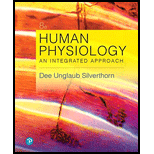
Concept explainers
The three types of muscle tissue found in the human body are ______, ______, and ______. Which type is attached to the bones, enabling it to control body movement?
Introduction: The main objective of muscles is to support the locomotion or movement of an organism. The muscle tissues form the muscular system of the body which is responsible for the various activities that are performed by an organism.
Answer to Problem 1RQ
Correct answer: The three types of muscle tissue found in the human body are smooth, cardiac, and skeletal.
Explanation of Solution
The basic structural unit that constitutes the whole network of muscle is known as a sarcomere. The three types of muscle tissues, which are found in the human body, are skeletal, smooth, and cardiac muscles. The basic structure of these muscles is given below:
- Smooth muscles:
These muscles are involuntary in nature and form the supporting tissues of internal organs, intestine, stomach, and blood vessels.
- Cardiac muscles:
The cardiac muscles are the specific muscles of the heart. These muscles supply blood to the heart.
- Skeletal muscles:
Skeletal muscles are striated voluntary muscles which are under the control of “somatic nervous system (SNS).” These muscles are present in a direct contact with the skeleton.
The three types of muscle tissues which are found in the human body are smooth, skeletal, and cardiac muscle.
To determine: The type of muscle which is attached to the bones and enables to control the body movement.
Introduction: The movement of muscles takes place by the process of muscle contraction. In this process, the protein filaments of muscles which are myosin and actin slide over each other to perform the process of movement.
Explanation of Solution
The movement of the body is controlled by the skeletal muscles of the body. These muscles are attached to the bones and support the voluntary movements of the body. The skeletal muscles are controlled by the somatic nervous system (SNS) of the body.
Skeletal muscles are attached to the bones for the movement of the body.
Want to see more full solutions like this?
Chapter 12 Solutions
Human Physiology: An Integrated Approach (8th Edition)
- Amino Acid Coclow TABle 3' Gly Phe Leu (G) (F) (L) 3- Val (V) Arg (R) Ser (S) Ala (A) Lys (K) CAG G Glu Asp (E) (D) Ser (S) CCCAGUCAGUCAGUCAG 0204 C U A G C Asn (N) G 4 A AGU C GU (5) AC C UGA A G5 C CUGACUGACUGACUGAC Thr (T) Met (M) lle £€ (1) U 4 G Tyr Σε (Y) U Cys (C) C A G Trp (W) 3' U C A Leu בוט His Pro (P) ££ (H) Gin (Q) Arg 흐름 (R) (L) Start Stop 8. Transcription and Translation Practice: (Video 10-1 and 10-2) A. Below is the sense strand of a DNA gene. Using the sense strand, create the antisense DNA strand and label the 5' and 3' ends. B. Use the antisense strand that you create in part A as a template to create the mRNA transcript of the gene and label the 5' and 3' ends. C. Translate the mRNA you produced in part B into the polypeptide sequence making sure to follow all the rules of translation. 5'-AGCATGACTAATAGTTGTTGAGCTGTC-3' (sense strand) 4arrow_forwardWhat is the structure and function of Eukaryotic cells, including their organelles? How are Eukaryotic cells different than Prokaryotic cells, in terms of evolution which form of the cell might have came first? How do Eukaryotic cells become malignant (cancerous)?arrow_forwardWhat are the roles of DNA and proteins inside of the cell? What are the building blocks or molecular components of the DNA and proteins? How are proteins produced within the cell? What connection is there between DNA, proteins, and the cell cycle? What is the relationship between DNA, proteins, and Cancer?arrow_forward
- please fill in the empty sports, thank you!arrow_forwardIn one paragraph show how atoms and they're structure are related to the structure of dna and proteins. Talk about what atoms are. what they're made of, why chemical bonding is important to DNA?arrow_forwardWhat are the structure and properties of atoms and chemical bonds (especially how they relate to DNA and proteins).arrow_forward
- The Sentinel Cell: Nature’s Answer to Cancer?arrow_forwardMolecular Biology Question You are working to characterize a novel protein in mice. Analysis shows that high levels of the primary transcript that codes for this protein are found in tissue from the brain, muscle, liver, and pancreas. However, an antibody that recognizes the C-terminal portion of the protein indicates that the protein is present in brain, muscle, and liver, but not in the pancreas. What is the most likely explanation for this result?arrow_forwardMolecular Biology Explain/discuss how “slow stop” and “quick/fast stop” mutants wereused to identify different protein involved in DNA replication in E. coli.arrow_forward
 Human Biology (MindTap Course List)BiologyISBN:9781305112100Author:Cecie Starr, Beverly McMillanPublisher:Cengage Learning
Human Biology (MindTap Course List)BiologyISBN:9781305112100Author:Cecie Starr, Beverly McMillanPublisher:Cengage Learning Human Physiology: From Cells to Systems (MindTap ...BiologyISBN:9781285866932Author:Lauralee SherwoodPublisher:Cengage Learning
Human Physiology: From Cells to Systems (MindTap ...BiologyISBN:9781285866932Author:Lauralee SherwoodPublisher:Cengage Learning
 Biology 2eBiologyISBN:9781947172517Author:Matthew Douglas, Jung Choi, Mary Ann ClarkPublisher:OpenStax
Biology 2eBiologyISBN:9781947172517Author:Matthew Douglas, Jung Choi, Mary Ann ClarkPublisher:OpenStax





